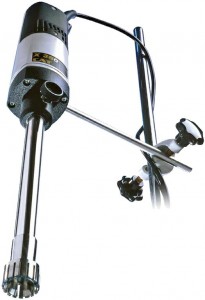How to Operate a Laboratory Homogenizer
 Operating a laboratory homogenizer may at first glance appear to be a relatively simple exercise. What could be simpler? Plug it in and start the mixing operation. But hold on for a moment. You have a relatively costly instrument in your hand that is designed to accomplish a variety of mixing, stirring, emulsifying and dispersing functions. Operating it incorrectly may lead to unsatisfactory results at the low end and cause damage or spillage at the high end.
Operating a laboratory homogenizer may at first glance appear to be a relatively simple exercise. What could be simpler? Plug it in and start the mixing operation. But hold on for a moment. You have a relatively costly instrument in your hand that is designed to accomplish a variety of mixing, stirring, emulsifying and dispersing functions. Operating it incorrectly may lead to unsatisfactory results at the low end and cause damage or spillage at the high end.
Basic Tips for Operating a Lab Homogenizer
In the paragraph above we noted the “costly instrument in your hand.” But when using the lab homogenizer it should not be “in your hand.” Yes, they are small, they are light in weight and there’s a temptation, especially for short mixing cycles, to hold the drive motor while operating the unit.
Bad move.
Why is that? The generator, also called the rotor-stator assembly, operates at very high (but user controlled) revolutions per minute. For maximum effectiveness, the generator should remain offset from the bottom of the flask or beaker holding samples. This avoids a vortex. There’s also the danger of causing contents to splash from the container if the operator is not paying close attention.
Hand fatigue may play a role, and in an extreme case the generator could strike the container and break it. Another point: It’s difficult if not impossible to control the speed of the generator drive motor when holding the unit.
The takeaway: Always use the drive stand assembly shipped as standard with CAT homogenizers. Although we do offer what we bill as the X120 hand held drive, we also recommend using the drive stand assembly with it.
Use the Right Homogenizer Tool for the Job
Mechanics, plumbers, carpenters, electricians and DIY enthusiasts know that jobs always go easier with the correct tools. So it is with operating a lab homogenizer. You’ll need to invest in the correct homogenizer tools that meet your requirements.
The Drive Motor
CAT Scientific stocks a variety of homogenizer drive units one of which should meet your needs. CAT offers choices in power (i.e. 125 to 1700 watts) and processing speed (4,000 to 45,000 RPM). Power is distinguished from generator speed, and power does not equate to rotor speed. Most homogenizer drive motors such as offered by CAT Scientific provide variable speed control. The good news here is that these drive motors accept more than one generator assembly (just as an electric drill accepts more than one bit size).
The Rotor-Stator (Generator) Assembly
Mismatching the homogenizer generator to the task at hand will certainly lead to unsatisfactory results. Not all rotor-stator assemblies work with all drive motors so check specifications before buying. We suggest you check our recent post on homogenizer generator specification tips for details on how these work.
Assemble Homogenizer Components Correctly
Who can argue? Take the time to make certain that all components are firmly in place. That includes that the rotor, stator and generator assembly are tightly mounted using the supplied mounting wrenches.
Use the Drive Motor Mounting Bracket
We say it again! Your attention is apt to wander when attempting to manually hold a drive motor at the correct angle and the generator assembly at the correct level in the beaker. In addition to risking splashed samples or breaking flasks your time can better be spent preparing new samples or recording results.
Correctly Position the Generator in the Sample
Immerse the shaft tube cooling port(s) during homogenizing operations. This provides protection against component overheating that can damage bearings and seals.
Safety First
Homogenizer rotor and stators have very sharp teeth. Be careful handling them especially after they have been used and contaminated with samples.
Clean All Assemblies after Use
Clean rotor-stator generator assemblies including tubes and drive shafts after use and be careful about samples that may be corrosive. Note that samples that dry inside the stator tube assembly can damage seals and bearings and possibly destroy the mechanism. Check our article on homogenizer cleaning tips for details on this important function.
And, in closing, as the cynics say, if all else fails read the operating manual for your CAT homogenizer.
With proper care your CAT homogenizer should give years of service. Feel free to contact us for assistance in picking the correct model along with compatible dispersing shaft assemblies.
